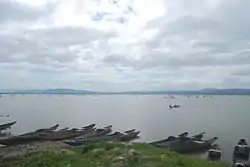Lake Bato
Lake Bato is a freshwater lake and the 7th largest in the Philippines. It is located in the town of Bato, approximately 9 kilometres (5.6 mi) southwest of Iriga City, Camarines Sur Province, southeastern Luzon, Philippines. It has extensive marshes and swamp forests. The lake drains into a tributary of the Bicol River which enters the sea near Naga City. Average depth is 8 metres (26 ft), and the bottom is muddy clay. The pH value is 6.1, the average dissolved oxygen 10 p.p.m., and the total hardness (SBY) 2.4.[1]
| Lake Bato | |
|---|---|
 | |
.svg.png.webp) Lake Bato Location within the Philippines | |
 Map of Camarines Sur highlighting Lake Bato | |
| Location | Bicol Peninsula, Luzon, Bicol Region (Region V) |
| Coordinates | 13°20′00″N 123°22′00″E |
| Primary inflows | local run-off and several small streams |
| Primary outflows | a tributary of the Bicol River |
| Basin countries | Philippines |
| Surface area | 2,810 ha (6,900 acres) |
| Average depth | 8 m (26 ft) |
| Surface elevation | 10 m (33 ft) |
| Settlements | Bato |
History
The lake was originally called Caligno by natives living around the area and a small settlement was founded on its shores during pre-Spanish times; the early settlers thrived on the lake's rich resources and use it as a primary medium of travel. The settlement flourished on to become the present-day town of Bato, Camarines Sur and the lake came to be named after the town, which was established by a decree of the Superior Government (National Government) on February 15, 1758, when the Philippines was still under the Viceroyalty of New Spain.
The Sinarapan
Lake Bato is part of the Rinconada (Bicol) Lakes System, which also includes Lake Buhi and Lake Baao-Bula. It is known that the Sinarapan (Mistichthys luzonensis), the world's smallest commercially harvested fish in the world, is also found in its waters. Sinarapan literally means "caught by sarap" in Buhi in this early historical context. However, the same fish is called tabios in Bato, Nabua, Baao and Bula, Camarines Sur. The etymology of tabios, however, is quite vague. The name is not found in the scientific literature unlike "Sinarapan". It is believed that Tabios is only used in the vernacular pertaining to the local fishery.[2] At present, the Sinarapan is threatened by extinction due to over-fishing and other factors but efforts to conserve it are ongoing. Such is this specie's importance to the lake's ecosystem since it is endemic only to this region.
Notes
- ARBC.org - Philippine Wetlands Archived 2008-12-01 at the Wayback Machine (retrieved: 3-9-09)
- Reviving the Sinarapan: The World's Smallest Commercial Fish; Dr. V.S. Soliman; Haring Ibon Magazine Archived 2008-11-02 at the Wayback Machine (retrieved: 3-9-09)
References
- Source: US National Imagery and Mapping Agency (retrieved: 3-9-2009)
- Haribon Foundation
- Bureau of Fisheries and Aquatic Resources (1984–85)
- Rinconada Integrated Development Area Project Feasibility Study (1979)
External links
- Geographic data related to Lake Bato at OpenStreetMap
| Wikimedia Commons has media related to Lake Bato. |
